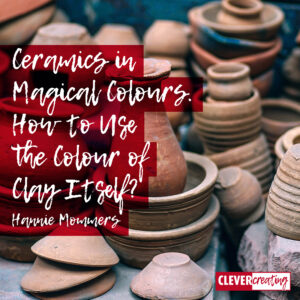
Decorating your ceramics can be done in many ways. Your clay object can be glazed or painted with engobes and underglazes. Even screen printing or applying transfers are possibilities.
A pure way of working is using the colour of the clay itself with at most a transparent glaze to emphasize the colours and make the object watertight.
Clay has different colours depending on the substances in the soil of the quarry. The clay you buy in the shops usually has only a few colours: it’s white, red, or ‘black’ (rather dark brown) after firing. Due to the industrialized process, the tones are generally the same every time.
Some of the links are affiliate links. As an affiliate associate, I earn a small commission when you purchase any of the products offered through the shared links at no extra cost to you. This helps me to maintain this website and I thank you for supporting me.
Table of Contents
How to use the colour of clay itself?
A ceramic object in its own colour, if necessary glazed transparently to emphasize that colour, has a charm of its own. Different colours of clay can also be used side by side or mixed.
Dutch Design in a pure form
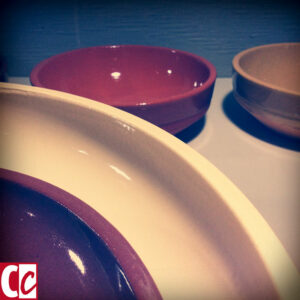
Since the 70s Dutch Design is a major export article. And that design covers all areas, like graphic design, industrial design and architecture.
Some great schools were accountable for the high level of their students. To name a few: the Delft University of Technology, the Design Academy Eindhoven, and the Academy for Art and Design St. Joost in Breda.
I had my education at the Academy of Visual Arts in Tilburg and at St. Joost, where I learned to have an inquisitive attitude. And it gives me a real boost if I see this spirit in others.
Clay is in the ground
Nowadays, some young people think every item comes from the store or the factory. They see no connection with the soil or with the cultivation of the land.
I once was at an exhibition of homespun wool and what I remember most of that exhibition is that one of the participants said she had discovered that sheep eat grass in the meadow! Duh!
On the other hand, of course, there is also a large group of young and older people that want to live consciously in regard to the environment and consider how fragile our planet is.
When you are a designer and you are interested in sustainability you might want to do the same as this Dutch girl did. Lonny van Ryswyck decided to go back to the roots for her graduation project for the Design Academy Eindhoven.
Sheer clay, pure colours
Armed with a bucket and a shovel, van Ryswyck travelled through the Netherlands and scooped clay in different regions. These regions used to be areas of clay extractions for household and industrial purposes.
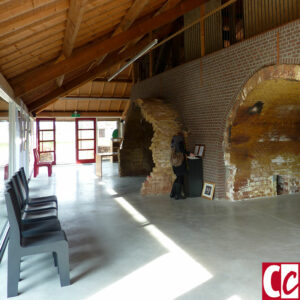
For example, Makkum, in Friesland, the north of the Netherlands, was famous for its tiles in the 17th century. Or Gilze, which is near my hometown, used to have large brick factories.
Clay consists of minerals with traces of metal oxides and organic matter. At each site, the clay has a different composition, which will result in different colours and a different degree of shrinkage.
Van Ryswyck did a meticulous examination of these varieties. She made a study of the composites, so now she knows what causes the colours.
Related: Dyeing with Plants, a Natural Way of Colouring Fabric or Paper
Can green be commercial?

A couple of years ago I heard Lonny in a lecture. She is really passionate about her work and rightly proud of it. And I am so happy for her that a factory – Koninklijke Tichelaar Makkum – has taken an interest in her designs and has put it into production.
She made equally sized moulds for each colour of tableware, thus making it visible that the shrinkage varies. The end result is a ceramic set with a beautiful variation of brown, ochre and white of which not one pair has the same size.
To top it off she stamped the names of the regions in the objects. You can imagine why I, as a former graphic designer and ceramist, was so delighted to see this project and its end products.
If you dig clay you can also dug it
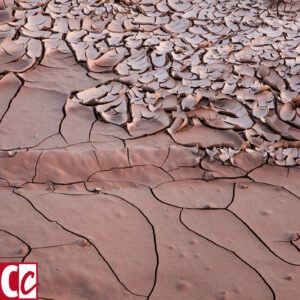
Going back to the roots and being sustainable yourself, is surely a possibility. It’s not that hard to shovel your own clay and prepare it.
- Dig up clay from a field or from an area near a river;
- Let it rest outside for the winter season. This is called ‘let the clay rot’;
- Break it into small pieces and ground it;
- Add water and sift it in order to remove plant debris and little stones;
- Let it rest for a while and pour off the water that forms on top;
- Let the clay dry to a kneadable thickness. You can do this by either warmth or spreading it on plaster plates;
- Knead or grind it into a uniform composition;
- Store it cool and moist;
- Before working with the clay you can add grog or paper to your liking. Depending of course on what you want to make with it.
Related: The Inspiration, Process, and Results of my Abstract Ceramics
Various ways to decorate with just the colour of the clay
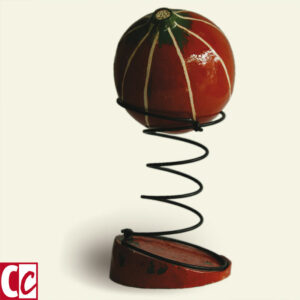
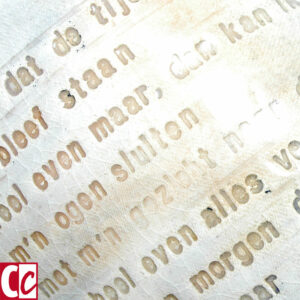
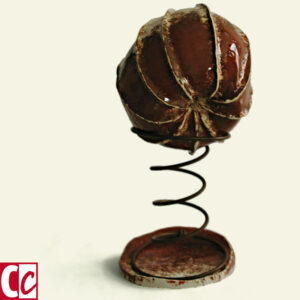
You can use the texture of the building technique with rolls or slabs, as I did in my big “Reaching for the sky”-series.
Related: How to Make the Perfect Clay Rolls with an Unveiled Secret Solution
Pressing stamps in the clay is another great way to decorate.
For a series inspired by nature, I carved the surface when the object was leather-hard and filled the grooves with a different colour of clay (see picture on the left above).
From leftover clay, I made an engobe, so I could paint parts in another colour, as you can see in the shape inspired by Physalis (see picture on the right above).
Do you have more ideas on how to decorate with just the colour of the clay? Tell me in the comment box below.
This article is an update. Originally published on 3-05-2013.



Wow, this project of Lonny, digging up clay all over the Netherlands and making a table set with the different sorts of clay is really amazing! I had never heard of her and her project before.
Your own beautiful ceramics are well known to me, but never stop to impress me. Lucky me, I also have access to (a part of) your ceramics, not only to the pictures of your gorgeous work 😉
Yes, it’s incredible, isn’t it? I totally agree. And like everybody who is a fanatic in their work, her lecture was also marvellous! The meticulous character of her investigation appealed to me very much. And it’s for sale in lots of Dutch museums as well. Boymans van Beuningen had it at the time, maybe they still sell it. 🙂
Thanks for your compliment, Kadanza! Sadly, I forgot which work of me you own. 🙁 I only know of the small cobblestones with letters. 🙂
I only own the letters… But my mom has one of your books, my aunt and uncle have one of your orbs and a big plate with salamanders 😍
Ahh yes, I remember those ones 😀
GRRR the sphere was called and your aunt decorated it every year with a Christmas hat 😂 I guess she still does that? She was afraid I would be insulted by that but I had to laugh because it was such a funny thing to look at.
You’re much into colouring these days. Dyeing with plants. Now the use of the colour of clay. Inspiring!
And what great results. Several times I tried to work with colour. Some painting, some photography. Always got the combinations wrong.
Yesterday, I saw this fabulous documentary on ARTE-tv about gothic art (mainly German). To my surprise, and this must do your Dutch heart some good, the Dutch painter Lucas van Leyden is central to the changes in European painting at the beginning of the 15th century.
When you look at his paintings you can see how he uses colour to give his paintings a three-dimensional outlook. He was the first to do this. Amazing.
One of the curators who was interviewed explained that Van Leyden could be called one of the first great individual modern artists, and not just a very sophisticated painter or craftsman. Because Van Leyden had to use his brain, his intellect, to be able to paint the way he did. The difference is that a craftsman painter relies more on his routines.
The documentary also made me realize how extremely difficult it is to use colour in art. The way you do it is also very exceptional.
Thanks for your compliments, John. Again, I might add. 🙂
Are you sure your combinations were wrong when you tried things out in colour? We are so easy in dismissing our work, yet self-criticism is not always an aid to getting any further. I would take another look at those works and try to discover what does make sense and what parts you don’t like and why. That way you will get yourself a step further. Also, I am most willing to have a look together with you in a Skype or Zoom session. Just let me know.
It’s so marvellous you enjoyed the documentary about Lucas van Leyden. ARTE has a lot of programs like that, don’t they? And of the same quality as the BBC often has. Van Leyden’s time was the period when science became more important in the Western world and that indeed shows in the way artists regarded their work.
It is true that a craftsman will rely on routine but one can only build routine through study and experience. So it’s not just a spark from the sky that will light craftsmanship. 🙂
Do have a look at the work of Hans Memling and Hans Holbein. You will surely like those as well!
Thank you for your response. It’s not that important, but the documentary wasn’t about Van Leyden. It was about (German) gothic art in general. Van Leyden was only mentioned briefly, albeit as the most significant European painter in those days.
Your remark about the increased importance of science in the 15th century I find intriguing. I’ve never looked at it that way. I always imagined science to become more important in the 18th century, in The Age of Wonder. Magnificent book by the way from Richard Holmes.
I totally agree with you about craftsmanship. Blood, sweat, and tears (experiment, study, and experience) determine the life of a true craftsman or -woman. But a craftsman, at least in my opinion, is not an artist. Although an artist is always a craftsman or -woman, as in your case.
The true value of the Internet is that one can immediately follow up on any advice given. Memling and Holbein are indeed fabulously great painters as well. Thank you for this tip.
Hi John, German Gothic art was coming to an end in the 15th century. Yet, in Italy, the Renaissance started already in the 13th century. Artists like Leonardo da Vinci incorporated a lot of science into their work. The study of anatomy, even though it was forbidden by the church and the government. In Leonardo’s case even the study of aerodynamics and such.
I can imagine for you science sort of started in the 18th century. I just always studied art history more than ‘the usual’ history. It has a reason that for a long time art and science were mentioned in the same breath. 🙂
I am so glad you like Memling and Holbein as well! Thanks for your reply and keep on enjoying art.